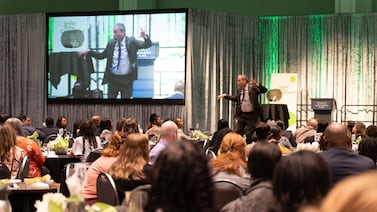Since COVID-19 precautions closed her campus and moved her job to her home, third-grade bilingual teacher Lisset Rosales has revised — multiple times —how she teaches reading and what she expects from her students at Grover Cleveland Elementary in Chicago’s Irving Park neighborhood.
She’s on the phone or on video encouraging one parent or another many times a day. She created a weekly schedule, but also allows students to turn in assignments at 11 p.m. — all lessons she’s learned as she adjusted to virtual teaching.
“I felt like I was starting all over again the school year, in the middle of March,” Rosales said.
Teachers like Rosales have pivoted from their previous routine, away from much of their lessons, without a roadmap, and are plotting out how to teach students from a distance. For early elementary teachers, perhaps no subject is as critical as reading, the basis of their students’ future academic, and broader, success. Reading proficiently by the end of third grade is linked to high school graduation and eventual job earnings.
But the disruption of closing campuses and unexpectedly shifting to home learning almost certainly will hurt reading progress.
Timothy Shanahan, a professor of curriculum and instruction at the University of Illinois Chicago, said there is little research on what an upheaval of this magnitude could do to learning, but that research about the loss of skills during summer break shows that students from under-resourced backgrounds or struggling with trauma suffer more severe losses.
“There is just no question this will be harder than what they are used to, for both students and teachers,” said Shanahan, the former director of reading for the Chicago Public Schools who took over a broad and ambitious district reading initiative in 2001.
Even before the COVID-19 pandemic, the country lacked agreement on the best way to teach children to read. Chicago adopted a common but controversial approach known as balanced literacy. It uses individual and group reading, context clues, some phonics, and writing practice. Critics say that method, often used in teacher training programs throughout Illinois, is not supported by science on how children learn basic literacy skills.
Still, most common reading curriculums assume one key factor: that children are taught in person. In Chicago, reading instruction has varied widely because the district gives each school freedom to choose its own curriculum and instructional approach. That has left some students, particularly those who move between schools often, to fall through the cracks.
Now there are even more variables, as teachers try to rebuild lesson plans to teach critical skills, while also confronting hurdles related to tech access and enticing students to actively participate in online learning.
Teachers have developed various techniques to teach reading remotely and manage their students, but they are finding it hard to accurately assess whether students are comprehending their lessons.
Teachers also worry about the emotional impact of the pandemic, which has cost more than 1,600 lives in Cook County, taking the heaviest toll in black and Latino neighborhoods.
Principal Kathleen Valente set a standard of engagement for teachers at Barnard Elementary —15-minute slots for reading out loud and discussing a project, or 15 minutes of guided writing on a daily topic, followed by a story break.
She also is having students read books that help them talk about their feelings and engage with the social aspect of reading.
“Some of our students might be hearing things on the news that are scary, and reading books helps them identify those feelings,“ she said.
Fourth grade teacher Mishawna Manning also has noticed her students at Kozminski Community Academy under stress. She considers that in planning lessons.
“I’ve structured my lessons so that students can access pretty much everything they do in their own time,” she said.
Other teachers are planning readings that help young students articulate emotions and feelings and record themselves reading books. They build in time to help younger students learn new technology, and finds creative ways to judge comprehension.
But for students, working alone has limits.
Barbara Foorman, a reading expert at Florida State University, said the ability of teachers to work with students in small groups, and really see whether a student is comprehending lessons, is critical in learning to read. Those pieces, particularly comprehension, are significantly more complicated when educators are teaching on the other side of a screen.
“At this age it is essential, they can’t do it on their own,” Foorman, who is schooling her granddaughter during the pandemic, said.
She said an in-person element is critical. “That human connection is really important. It can work [without it] but teachers really need training in how to do this.”
Foorman said that floundering students could fall even further behind with remote learning.
“Online learning is likely just to exacerbate the problems you see in a balanced literacy classroom where kids are just falling further and further behind because they are not getting enough practice in a variety of patterns“ of reading instruction, she said. ‘Without immediate feedback, that is even harder.“
Caregivers can help younger students access technology like Zoom or Google that are used in remote learning, and often may follow along on lessons and assignments. At the same time, educators sometimes remind parents not to get frustrated at the pace of children’s learning, and to refrain from providing answers, so that they can learn for themselves.
Krystle Barnes, a second grade teacher at Chicago International Charter School’s Lloyd Bond school, asks her students to show their work to a parent or sibling to get another pair of eyes on their work, or even to a stuffed animal to recreate the camaraderie of a classroom.
But before getting to the lesson, students have to confront, and conquer, the technology.
On some days, Cicely Perry’s kindergartner is excited to read “the dog went out” in books. On others, the 6-year-old refuses to appear on camera for her video lesson.
No two days have looked the same, said Perry, the choral director at Westinghouse High School.
Likewise, Matthew Brown’s 5-year-old daughter, who attends pre-kindergarten at Scammon Elementary, is still terrified of Zoom.
“She will cover her face the whole time, and won’t say a word,” Brown said. The teacher started off remote learning with a daily Zoom meeting where 30-some classmates were invited, but then pivoted to small groups of five or so students.
In addition, Brown worries that his daughter’s attention span has become briefer than before.
“My worry is she will get used to a world where she doesn’t have to sit still for more than 20 minutes at a time,” said Brown, formerly a sports journalist. “That will be a challenging transition from pre-K to other grades.”
Shanahan of the University of Illinois at Chicago agrees that capturing students’ attention will be paramount to making sure they learn.
“I don’t think the big issue or big problems are with the skills of reading,” he said. “It’s an attention problem.”
Patti Freckleton, a preschool special education teacher at Bateman Elementary, worries that students who don’t want to get on video chats may miss out on instruction. And even those who do, who are tracing letters onto a screen, might lose some of their fine motor skills.
She is most worried about students losing social skills, particularly students in special education.
“I worry they have regressed in terms of being able to play with other kids, being able to use their words,” she said.
Freckleton introduces one letter per week, then has students interact with it differently each day, either looking at pictures of the sounds it makes, tracing the letter, and then sending them a recording of their activities.
As the school year is nearing its end, even as the new regimen has just begun, educators are thinking about how to assess what has been gained and lost, how classrooms may change once students return, and how to teach students who may return at vastly different levels in reading.
L’rae Robinson, a kindergarten teacher at Mount Vernon Elementary in Washington Heights, expects next fall it could take weeks longer than usual to acclimate students coming out of months of isolated learning to adapt to behavioral norms for the classroom.
And learning could look altogether different — teaching about shapes on the playground instead of in classrooms sitting quietly at desks.
“How do we manage our excitement about being around our friends,” she asked, “and still learn at the same time?”







